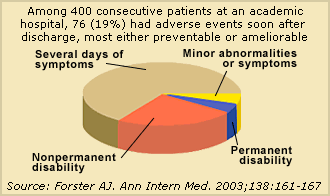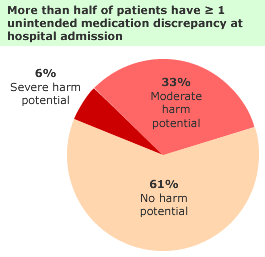Background
Being discharged from the hospital can be dangerous. A classic study found that nearly 20% of patients experience adverse events within 3 weeks of discharge, nearly three-quarters of which could have been prevented or ameliorated. Adverse drug events are the most common postdischarge complication, with hospital-acquired infections and procedural complications also causing considerable morbidity. More subtle discharge hazards arise from the fact that nearly 40% of patients are discharged with test results pending, and a comparable proportion are discharged with a plan to complete the diagnostic workup as an outpatient, placing patients at risk unless timely and complete follow-up is ensured. As nearly 20% of Medicare patients are rehospitalized within 30 days of discharge, minimizing post-discharge adverse events has become a priority for the US health care system.

Systematic problems in care transitions are at the root of most adverse events that arise after discharge. Discontinuity between inpatient and outpatient providers is common, and studies have shown that traditional communication systems (such as the dictated discharge summary) generally fail to reach outpatient providers in a timely fashion and often lack essential information. Patients frequently receive new medications or have medications changed during hospitalizations. Lack of medication reconciliation results in the potential for inadvertent medication discrepancies and adverse drug events—particularly for patients with low health literacy, or those prescribed high-risk medications or complex medication regimens.

Source: Cornish PL, Knowles SR, Marchesano R, et al. Unintended medication discrepancies at the time of hospital admission. Arch Intern Med. 2005;165:424-429. [go to PubMed]
Even if communication between providers is timely and accurate, and appropriate steps are taken to ensure medication safety, patients and their families still assume a large burden of care after discharge. Accurately assessing patients' abilities to care for themselves after discharge can be difficult and requires a coordinated multidisciplinary effort. Failure to enlist appropriate resources to help with the transition from hospital to home (or another health care setting) may leave patients vulnerable. Finally, the fragmented nature of the health care system may limit individual hospitals' incentive to improve their discharge process, despite the benefits to patients that may result.
Preventing Adverse Events after Discharge
Ensuring safe care transitions requires a systematic approach. Three key areas must be addressed prior to discharge:
- Medication reconciliation: The patient's medications must be cross-checked to ensure that no chronic medications were stopped and to ensure the safety of new prescriptions.
- Structured discharge communication: Information on medication changes, pending tests and studies, and follow-up needs must be accurately and promptly communicated to outpatient physicians.
- Patient education: Patients (and their families) must understand their diagnosis, their follow-up needs, and whom to contact with questions or problems after discharge.
No consensus exists on how to ensure patient safety after hospital discharge, but some evidence indicates that comprehensive, multi-modal interventions may be more effective at preventing rehospitalization than targeting individual components of the discharge process. Two notable interventions used specially trained staff to meet with patients before (and sometimes after) discharge to reconcile medications, instruct patients and caregivers in self-care methods, prepare patient-centered discharge instructions, and facilitate communication with outpatient physicians. These studies, the Care Transitions trial and the Project RED study, both successfully reduced readmissions and emergency department visits after discharge. By contrast, medication reconciliation alone does not appear to reduce rehospitalization risk (but likely prevents medication errors), and other strategies such as structured postdischarge phone calls to patients and ensuring early follow-up appointments also lack supporting evidence. There is considerable interest in harnessing the power of checklists to standardize the discharge process, and electronic health records offer great potential for improving information transfer between inpatient and outpatient physicians and developing standardized discharge instructions for patients.
Evaluating the magnitude of care transition problems and the effect of interventions is hampered by the lack of a standard outcome measurement. Hospital readmission rates are often used, but most adverse events after discharge cause patient harm without requiring readmission. A three-item patient survey measure has been developed to measure patient satisfaction with the transition process; hospitals are being encouraged to add these items to standard patient satisfaction questionnaires.
Current Context
The Center for Medicare and Medicaid Services began publicly reporting hospital readmission rates for certain conditions in 2009. The Patient Protection and Affordable Care Act of 2010 contains multiple payment reforms intended to encourage hospitals to address and prevent adverse events after discharge. Beginning in 2012, hospitals with above-average readmission rates are subject to financial penalties from CMS. Hospitals will also receive “bundled” payments for target illnesses that will cover all costs associated with patient care for a 30-day period, providing a financial incentive to ensure continuity of care.